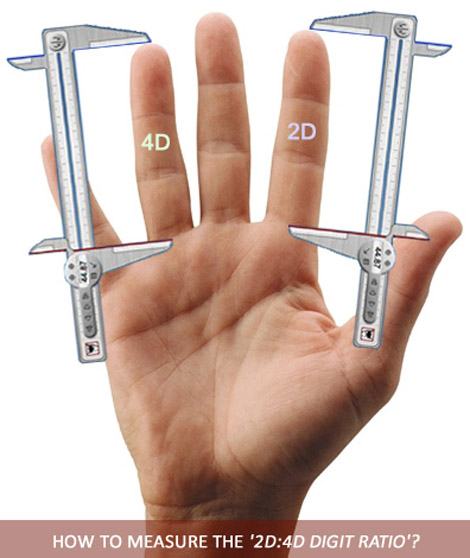

Similarly, women with polycystic ovarian syndrome (PCOS) that presumably relates to increased prenatal testosterone level have lower than normal 2D:4D ( Cattrall et al. Furthermore, CAH, which leads to excessive prenatal androgen production, has been shown to be related to low 2D:4D in both sexes ( Brown et al. 2010) and that 2D:4D does not markedly change from childhood to adulthood ( McIntyre et al. In humans, the evidence for this hypothesis comes from studies showing that 2D:4D is sexually dimorphic with lower ratios among males than females from the end of the first trimester of fetal development onwards ( Manning et al. 2008), it is generally postulated that the lower the individual 2D:4D, the higher testosterone but the lower estrogen levels experienced during fetal life. Although the underlying causal connections remain still elusive ( Forstmeier et al. One noninvasive retrospectively available measure, the ratio of second-to-fourth digit lengths (2D:4D), has been highlighted as a potentially useful phenotypic marker of steroid exposure in utero in vertebrates ( Manning 2002, 2008 McIntyre 2006). For example, congenital adrenal hyperplasia (CAH), a medical disorder causing elevated testosterone levels during prenatal development, has been shown to impair growth and fertility in both women and men ( New 2004 Merke and Bornstein 2005). Therefore, most of our current understanding on the effects of prenatal steroids (mainly testosterone) on later-life performance in humans comes from indirect observations.

Such effects are, however, inherently difficult to study and manipulate in most vertebrate species, particularly in humans due to ethical issues. Prenatal steroids have also been considered to play a role in the programming of later-life reproductive performance ( Cohen-Bendahan et al. For example, in humans low birth weight for gestational age and prematurity at birth have both been associated with increased mortality and impaired reproductive success in adulthood, leading to reduced long-term individual fitness ( Swamy et al. Recent decades have witnessed a growing understanding of the importance of prenatal programming on individual's subsequent physiology, behavior, phenotype, and ultimately on reproductive success ( Lindström 1999 Lummaa and Clutton-Brock 2002 Gluckman and Hanson 2005) that may last over generations ( Pembrey et al. These results thus cast doubts to the claim that 2D:4D predicts female life histories and evolutionary fitness in humans. We found no association between 2D:4D and the life-history traits studied and fitness among these Finnish women. We studied whether 2D:4D was associated with several life-history traits (probability of reproducing, adulthood height, ages at first and last reproduction, and interbirth intervals) and fitness (the number of offspring raised to adulthood) in postreproductive Finnish women, while controlling for education and spatio-temporal variation of traits. In addition, the life-history traits generating such fitness differences have received less attention in the literature. These studies have not, however, been conclusive as important confounding factors affecting completed family size (e.g., socioeconomic status) have not been accounted for and the vast majority of the participants examined have not yet ended their reproductive careers.

The evidence for 2D:4D being related to individual fitness comes largely from studies in humans. The ratio of second-to-fourth digit length (2D:4D) has been suggested to reflect prenatal steroid levels, which likely bear important consequences for vertebrate adult-age physiology, behavior, and reproductive success.


 0 kommentar(er)
0 kommentar(er)
